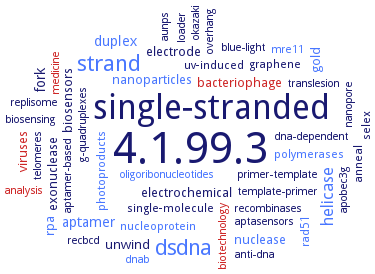4.1.99.3: deoxyribodipyrimidine photo-lyase
This is an abbreviated version!
For detailed information about deoxyribodipyrimidine photo-lyase, go to the full flat file.

Word Map on EC 4.1.99.3 
-
4.1.99.3
-
single-stranded
-
strand
-
dsdna
-
helicase
-
aptamer
-
fork
-
duplex
-
electrochemical
-
electrode
-
nanoparticles
-
viruses
-
bacteriophage
-
unwind
-
gold
-
biosensors
-
rpa
-
nuclease
-
exonuclease
-
selex
-
photoproducts
-
polymerases
-
uv-induced
-
rad51
-
graphene
-
single-molecule
-
nucleoprotein
-
anneal
-
primer-template
-
telomeres
-
biotechnology
-
biosensing
-
okazaki
-
analysis
-
recombinases
-
aptasensors
-
translesion
-
anti-dna
-
aptamer-based
-
dna-dependent
-
dnab
-
g-quadruplexes
-
overhang
-
template-primer
-
recbcd
-
oligoribonucleotides
-
replisome
-
nanopore
-
apobec3g
-
loader
-
aunps
-
mre11
-
blue-light
-
medicine
- 4.1.99.3
-
single-stranded
- strand
- dsdna
- helicase
- aptamer
- fork
- duplex
-
electrochemical
-
electrode
- nanoparticles
- viruses
- bacteriophage
-
unwind
- gold
-
biosensors
- rpa
- nuclease
-
exonuclease
-
selex
- photoproducts
- polymerases
-
uv-induced
- rad51
-
graphene
-
single-molecule
- nucleoprotein
-
anneal
-
primer-template
-
telomeres
- biotechnology
-
biosensing
-
okazaki
- analysis
-
recombinases
-
aptasensors
-
translesion
-
anti-dna
-
aptamer-based
-
dna-dependent
- dnab
-
g-quadruplexes
-
overhang
-
template-primer
-
recbcd
- oligoribonucleotides
- replisome
-
nanopore
- apobec3g
-
loader
-
aunps
- mre11
-
blue-light
- medicine
Reaction
Synonyms
AMV025, AnPL, AtCry1, AtCry3, AtPL, BcCRY1, BcCRY2, BCIN_05g08060, BCIN_09g01620, BsUvrC, Cc-phr2, CcPL, CDP photolyase, class I CPD photolyase, class I cyclobutane pyrimidine dimer photolyase, class I photolyase, class I PL, class II AtPL, class II CPD photolyase, class II CPD-DNA photolyase, class II CPD-photolyase, class II cyclobutane pyrimidine dimer photolyase, class II DmPL, class II DNA photolyase, class II photolyase, class II PL, class III PL, cold-adapted DNA photolyase, CPD class I photolyase, CPD photolyase, CPD photolyase photolyase, CPD specific photolyase, CPD-class I photolyase, CPD-photolyase, CPD-Phr, CPD-specific DNA photolyase, CPD1, CPD2PHR, CPDI, CPDII, CPDphr, CPH1, CPH1-PHR, CpPL, Cry-DASH, Cry1, Cry2, cry3, CryA, CRYD, cryptochrome 1, cryptochrome 3, CRYPTOCHROME DASH, cryptochrome-3, cryptochrome-DASH, CsPHR, cyclobutane pyrimidine dimer photolyase, cyclobutane pyrimidine dimer PHR, cyclobutane pyrimidine dimer specific photolyase, cyclobutane pyrimidine dimer-class I photolyase, cyclobutane pyrimidine dimer-specific DNA photolyase, cyclobutane pyrimidine dimers photolyase, CYME_CMA044C, cytochrome DASH, DASH cryptochrome, deoxyribodipyrimidine photolyase, deoxyribodipyrimidine photolyase type I enzyme, deoxyribonucleate pyrimidine dimer lyase (photosensitive), deoxyribonucleic cyclobutane dipyrimidine photolyase, deoxyribonucleic photolyase, dipyrimidine photolyase (photosensitive), DmPL, DNA cyclobutane dipyrimidine photolyase, DNA photolyase, DNA photolyase type I enzyme, DNA repair protein photolyase, DNA-photoreactivating enzyme, EcPL, eukaryotic Class II CPD PHR, eukaryotic class II cyclobutane pyrimidine dimer photolyase, lyase, deoxyribonucleate pyrimidine dimer, MmCPDII, MmPL, MM_0852, photolyase, photolyase I, photolyase orthologue, photoreactivating enzyme, PHR, phr A photolyase, PHR1, PHR2, phrA, PhrB, PhrB orthologue, PhrB photolyase, PL, PRE, primase, Saci_1227, ssDNA, ssDNA AtCRY3, ssDNA photolyase, ssDNA PL, SsPL, St-photolyase, tetur12g04440, tetur12g04460, tetur35g00010, tetur35g00030, thymine dimer by photolyase, VcCry1, VcPHR, Ver3Phr, VPA1471, XlCry-DASH


 results (
results ( results (
results ( top
top





